
A swaddled and sleeping baby
Family of four 🏡
08.10.2025 20:20 — 👍 8 🔁 0 💬 0 📌 0@patrickmckenzie.bsky.social
Postdoc in Harvard OEB -- Hopkins lab. systematics, speciation, hybridization in flowering plants. Natural history via community science. Previously Eaton lab at Columbia. Birder, Arkansan, he/him

A swaddled and sleeping baby
Family of four 🏡
08.10.2025 20:20 — 👍 8 🔁 0 💬 0 📌 0Webpage on the hidden curriculum of applying to ecology and evolution grad programs in the US (a lot of the info applies to other fields too, but perhaps less well): applyingtoeeb.info
#AcademicSky 🧪
I just passed my 50,000th identification on @inaturalist.bsky.social! Identifying is a huge but often ignored part of the #iNaturalist community and dataset so I wanted to share why and how I identify. 1/14
🧪 #ecology #taxonomy #botany #CommunityScience
super helpful guide!!!! and congrats on the milestone!
18.09.2025 20:54 — 👍 1 🔁 0 💬 1 📌 0super grateful to colleagues and reviewers who greatly improved early versions of this manuscript. We're really proud of it.
11.09.2025 19:51 — 👍 1 🔁 0 💬 0 📌 0there's value in leveraging linked genomic signals (vs. just unlinked gene trees) to learn about species history and demography. In the future we're hoping to see this plugged into species-tree inference and/or ARG inference pipelines.
11.09.2025 19:45 — 👍 3 🔁 0 💬 1 📌 0
MS-SMC predictions validated against coalescent simulations. (a) Results are shown for three models containing 1, 2, or 8 populations. For each model, 100K tree sequences were simulated for 10 different constant Ne values between 50K and 500K. (b) The distributions of summed edge lengths of the first genealogy in each tree sequence. (c-d) The mean frequency (black square) with which the first observed recombination event was a tree-change (c) or topology-change (d) in a simulated tree sequence, and the mean (colored circle) and 95% CI (grey fill) of the predicted probability of tree or topology-change calculated from the first embedded genealogy in each tree sequence. Probabilities are constant with respect to Ne in the single population model but vary in models with population structure (also shown with respect to species tree interval lengths in coalescent units, across the top axis). (e-f) The mean waiting distance (black square) until the first observed tree-change (e) or topology-change (f) in a simulated tree sequence, and the mean (colored circle) and 95% CI (grey fill) of predicted waiting distances calculated using the first embedded genealogy in each tree sequence.
We implement the math in ipcoal, and we validate against coalescent simulations. Finally, we demonstrate that there is information from observed waiting distances alone for fitting MSC parameters (Ne, divergence times, recombination rate).
11.09.2025 19:43 — 👍 2 🔁 0 💬 1 📌 0
Figure 2. An example genealogy embedded in a species tree and the corresponding embedding table used for MS-SMC calculations. (a) A four tip species tree is composed of seven discrete population intervals separated by speciation events (Wx), each of which can be further dissected by coalescent events (tx). (b) The probability of coalescence is constant within each discrete interval and is scaled by the number of lineages (k), the effective population size (n), and the interval length (d). Under the MS-SMC, the probability that a detached lineage will re-coalesce on a specific branch of the genealogy (e.g., branch 7) is calculated using the piecewise constant probabilities from each discrete interval spanning that branch (e.g., rows 1, 6, 7, and 8 in the embedding table).

Figure 4. The MS-SMC is a model of the probability of different categorical event outcomes given recombination occurring uniformly on a genealogy embedded in a parameterized MSC model (a). A recombination event can cause one of three possible recombination event types between two sequential genealogies in a genome: no-change, tree-change, or topology-change. The probability of these event types are calculated by integrating over each branch on the genealogy on which recombination can occur; which in turn is calculated by integrating over each position on a genealogy branch at which recombination can occur. (b-d) The probability that a recombination event causes a no-change, tree-change, or topology- change event, for the example genealogy embedded in a species tree, was calculated for three selected genealogy branches (2: red; 5: blue; and 7: purple), at each position along the branch where recombination could occur.
This *explicitly* links observable turnover in local ancestry to MSC model parameters.
11.09.2025 19:41 — 👍 4 🔁 0 💬 1 📌 0
figure illustrating the concept of an ARG, including recombination events that create no-change, vs. tree-change, vs. topology-change
alignments are mosaics of autocorrelated genealogies... nearby bases share ancestry until recombination alters the local tree. We derived the distributions of waiting distances for tree-change and topology-change events, extending prior single-population results to arbitrary species tree models.
11.09.2025 19:40 — 👍 6 🔁 4 💬 1 📌 0
super excited to share this big project with @daeaton.bsky.social out now in Systematic Biology! We derived distributions for -- given an arbitrary species tree model -- how far you have to move along a genome before observing a change in the underlying genealogy: doi.org/10.1093/sysb...
11.09.2025 19:36 — 👍 38 🔁 18 💬 1 📌 1
🌱 Calling all mentors!
The BSA Early Career Committee is bringing back the NSF GRFP Workshop. Sign up to be a mentor if you are a:
✅ Grad student who already received a GRFP or
✅ PI, postdoc, senior researcher
Sign up here 👉 forms.gle/sQUwhVryYHJK...
#NSFGRFP #botany
Interested in joining our lab (dunnlab.org) as a postdoc to work on siphonophores, processes that structure diversity in the open ocean, or natural history? If so, please reach out to discuss a nomination for the Donnelley Postdoctoral Fellowship - yibs.yale.edu/donnelley-fe...
11.09.2025 14:22 — 👍 31 🔁 37 💬 0 📌 0
When & where have species of bats, rodents, & shrews been collected across the 54 mountains of the Madrean Sky Islands?
Damien Rivera in our lab led this effort to find out!
New preprint "Uncovering historical small mammal biodiversity among the Madrean Sky Islands" www.biorxiv.org/content/10.1...
Really sorry to hear this. good thoughts your way.
29.08.2025 19:58 — 👍 1 🔁 0 💬 0 📌 0The Church Evolution Laboratory (CEL@NYU) will be official as of Sep 1st: shchurch.github.io. We are recruiting at all levels, including a postdoc to work on evolutionary patterns and processes via comparative genomics in Hawaiian Drosophila. Please share widely!
28.08.2025 18:16 — 👍 22 🔁 12 💬 0 📌 0I hope to take a PhD student in 2026 to study siphonophores. Please reach out if you are interested in applying this fall. For examples of recent lab projects see www.sciencedirect.com/science/arti... and academic.oup.com/gbe/article/...
28.08.2025 12:45 — 👍 54 🔁 46 💬 1 📌 1
Responses to climate change – insights and limitations from herbaceous plant model species
22.08.2025 01:00 — 👍 6 🔁 6 💬 0 📌 0I'm hiring a postdoc to work in theoretical / computational phylogenomics! More info at tinyurl.com/63hb5ew8. Please share!
21.08.2025 12:52 — 👍 24 🔁 38 💬 0 📌 0felt really lucky to be sitting in the room during Andrew's incoming president's lecture at Botany - really glad to see it preserved here!
21.08.2025 16:16 — 👍 7 🔁 0 💬 1 📌 0
Check out our preprint 🧪 on the origin & dispersal dynamics of a sailing ⛵ #siphonophore! We use #iNaturalist and particle tracking simulations to show that juvenile man o' war surface in the Gulf of Mexico & Straits of FL and disperse rapidly along the Gulf Stream 🌊
www.biorxiv.org/content/10.1...
Just want to shoutout a new study from the Wessinger Lab by my colleague @trinitydepatie.bsky.social. bsapubs.onlinelibrary.wiley.com/doi/10.1002/.... She investigated the repeated evolution of personate flowers within Penstemon by examining patterns of introgression, topological discordance, and
03.08.2025 08:51 — 👍 25 🔁 15 💬 2 📌 2This is an awesome summary of @trinitydepatie.bsky.social 's new paper!!! Thanks @aidanwshort.bsky.social ! Check it out folks!!!!
04.08.2025 15:16 — 👍 9 🔁 2 💬 0 📌 0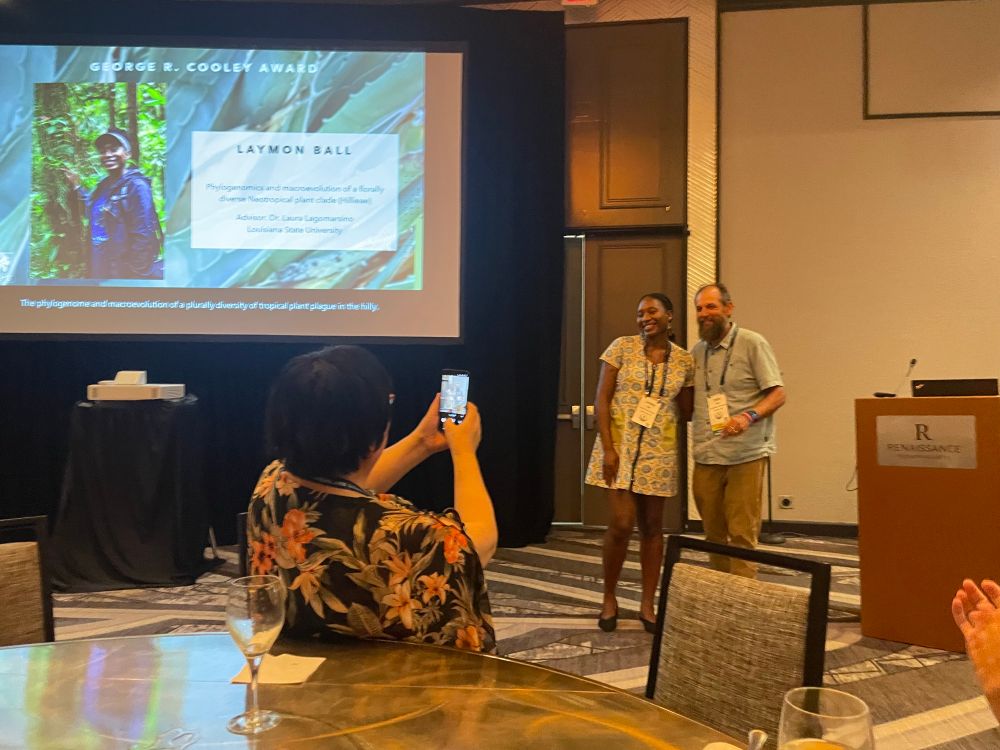
Laymon receives the award from Dave Tank.
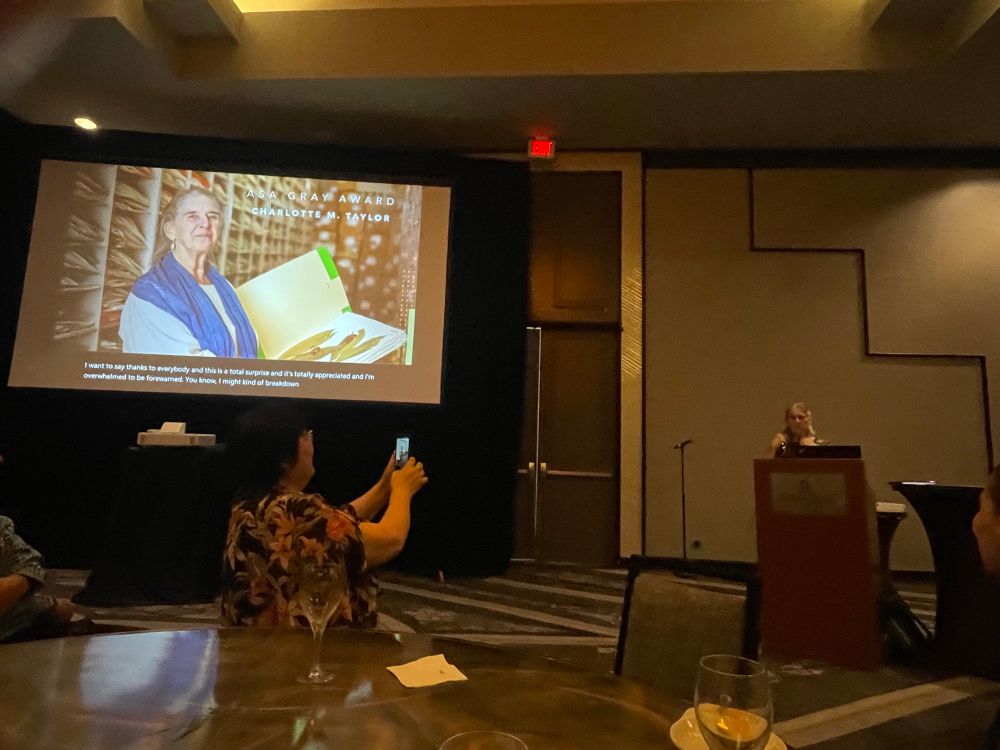
Charlotte gives the her statement after the award is announced.
What a night for #Rubiaceae! I’m so proud of my student @laymonstera.bsky.social for taking home the American Society of Plant Taxonomist’s Cooley Award for best talk, and my colleague and dear friend Charlotte Taylor for receiving the lifetime achievement Asa Gray Award. #Botany2025 #LagoLab
30.07.2025 07:14 — 👍 44 🔁 9 💬 0 📌 0😎😎😎😎
29.07.2025 22:46 — 👍 0 🔁 0 💬 0 📌 0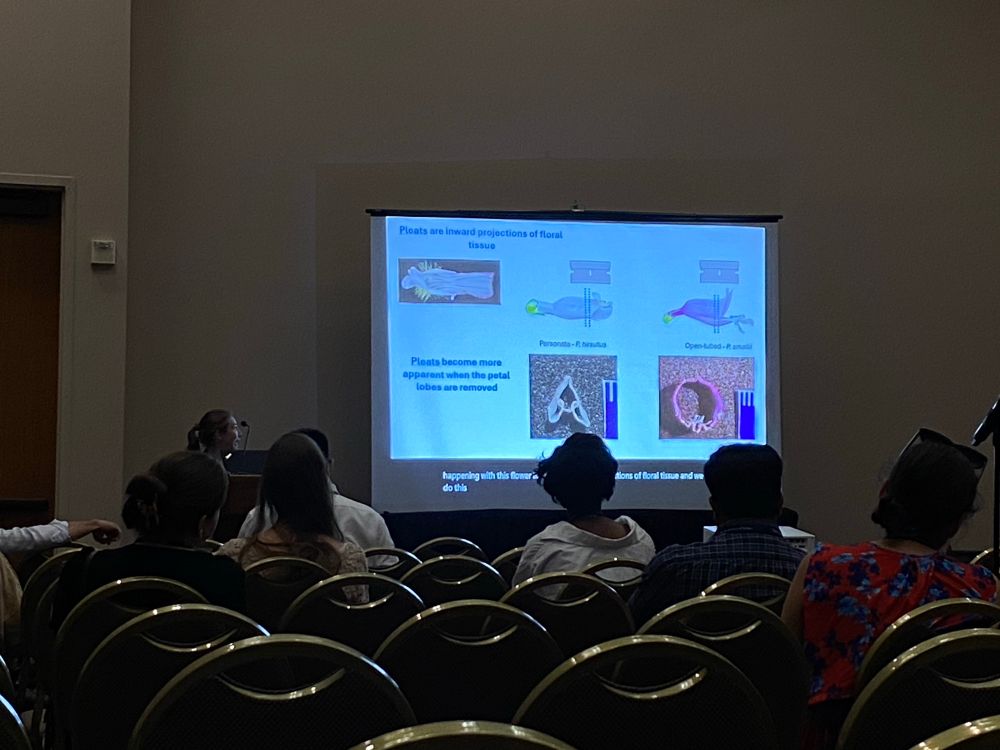
Trinity showing cross-sections from personate vs open flowers
Awesome Penstemon genetics work from @trinitydepatie.bsky.social !!! meticulous crossing design and such a clean result 🤯
29.07.2025 20:55 — 👍 8 🔁 0 💬 0 📌 1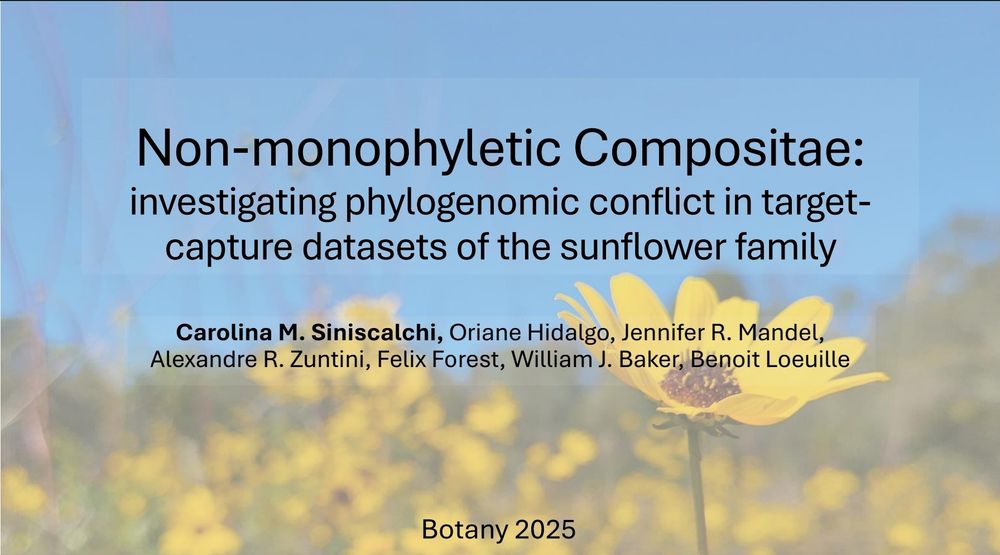
Screen grab of a slide, with the title "Non-monophyletic Compositae: investigating phylogenomic conflict in target-capture datasets of the sunflower family".
Hey #Botany2025 peeps! Come watch me blab about Comps tomorrow! Phylogenomics 2, Santa Rosa room, at 2:30 pm!
29.07.2025 16:31 — 👍 15 🔁 9 💬 1 📌 1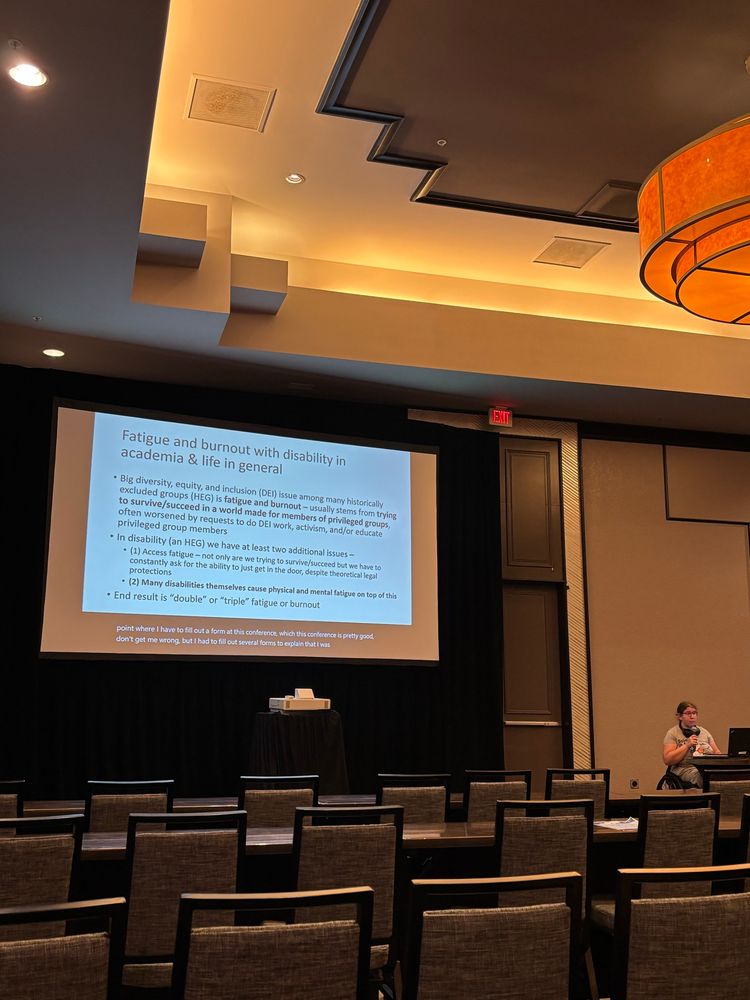
A white person in a wheelchair is speaking at a podium in front of slides. The slides heading states “Fatigue and burnout with disability in academia & life in general”
@plantpollinator.bsky.social sheds light on many of the issues related to having disabilities in academia, but in navigating social settings in general
28.07.2025 21:29 — 👍 5 🔁 4 💬 1 📌 0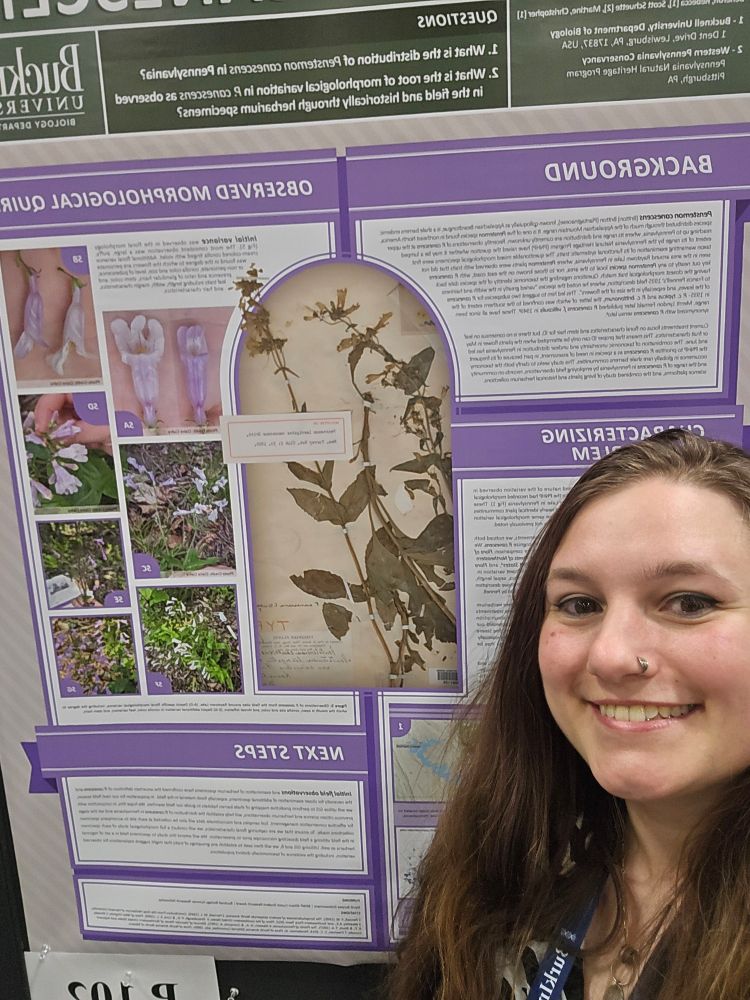
Wanna hear about eastern Penstemon funkyness? Stop by poster #102 at 6:15!
28.07.2025 20:55 — 👍 16 🔁 5 💬 1 📌 1